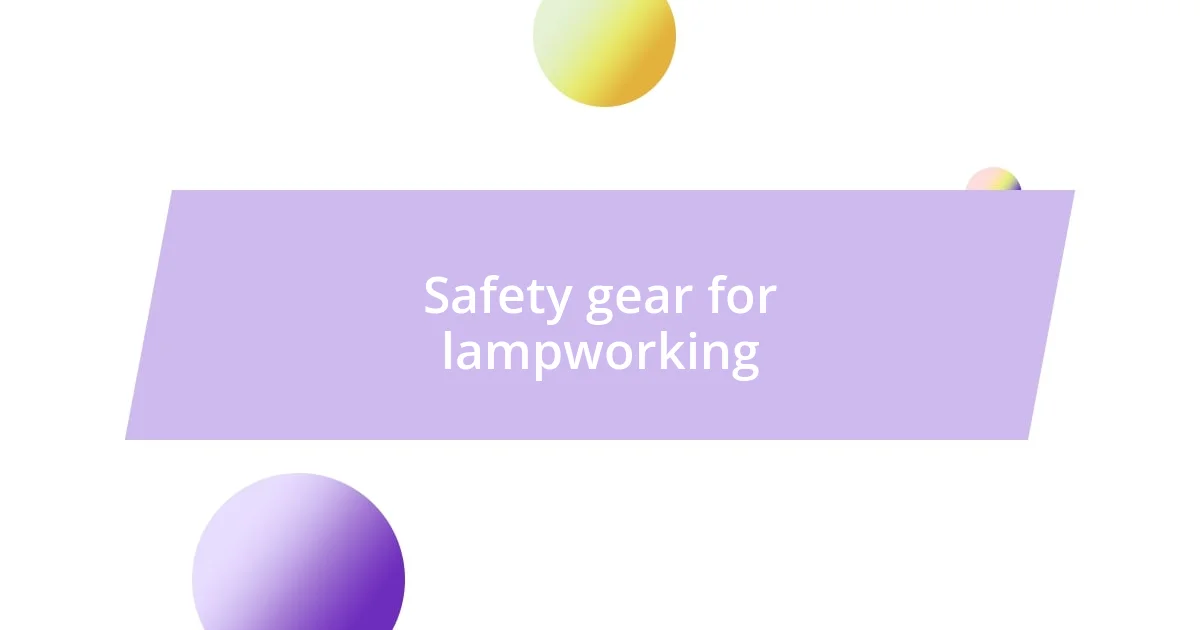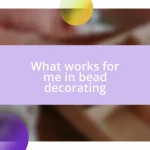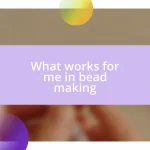Key takeaways:
- A quality torch and reliable flame control are essential for precision in lampworking.
- Understanding different glass types and selecting the right one is crucial for elevating artistic creations.
- Safety gear, including goggles and heat-resistant gloves, is non-negotiable for a safe lampworking experience.

Essential tools for lampworking
When I first delved into lampworking, I quickly discovered that a quality torch is an absolute necessity. I remember the excitement and slight anxiety the first time I fired up my minor burner. Watching the flames dance was mesmerizing, but I realized that having reliable flame control made all the difference in achieving precision in my beads.
Next on my list of essentials is a sturdy set of tools for shaping glass. I still vividly remember the first time I used a marver, feeling the smooth surface transform my molten glass into something elegant. The right tools don’t just increase efficiency; they enhance creativity, allowing for that magical flow which can truly make your work shine.
Don’t underestimate the importance of safety gear either. The first time I forgot my heat-resistant gloves, I learned the hard way that comfort shouldn’t trump safety. Isn’t it comforting to know that a simple pair of gloves and a good pair of safety goggles can pave the way for a more enjoyable and worry-free lampworking experience? I really can’t stress enough how crucial these tools are to not just creating, but thriving in this art form.

Glass types for lampworking
When it comes to lampworking, understanding the different glass types is pivotal for success. I remember my early days trying out various glass types, and it felt like I was on a quest to find the perfect match for my creative style. Each type of glass comes with its unique characteristics that can significantly affect your work.
Here’s a quick overview of some popular glass types for lampworking:
- Soft Glass (Soda Lime): This is the most common glass for beginners. It melts at lower temperatures and is easy to manipulate. I love how vibrant the colors can be, which allows for creative expression.
- Borocilicate Glass (Pyrex): Known for its durability, this glass withstands temperature changes beautifully. I often use it for making intricate pieces as it holds detail well, but it does require a higher heat.
- Frit: These are small pieces or granules of glass that can add texture and color. I often sprinkle frit onto molten glass to create stunning surface effects, and it adds a delightful surprise to my pieces.
- Crystal Glass: This glass has a sparkle and clarity that can elevate the elegance of any design. I usually reserve it for something truly special, as it enhances the overall aesthetic of my work.
Choosing the right glass can elevate your work from ordinary to extraordinary. It’s all about finding the right fit for your artistic vision!

Choosing the right torch
When I first started lampworking, the torch felt like an extension of myself. I tried a few torches before settling on one that sang to me—its flame was just right, offering precision and versatility. When choosing the right torch, consider its size and flame type, as this can really affect how easily you can work with the glass.
I remember experimenting with a few different models, including the hot head and minor torch. While the hot head is great for beginners, I found that the minor burner opened up a world of possibilities with its adjustable flame control. What I learned was that the choice of torch can significantly influence your overall comfort and the quality of your creations.
Here’s a quick comparison of different torch types to help you make an informed decision:
| Type | Flame Control | Best For |
|---|---|---|
| Hot Head | Fixed flame | Beginners |
| Minor Burner | Adjustable flame | Intermediate to Advanced |
| Major Burner | Highly adjustable | Professional work |

Safety gear for lampworking
When diving into lampworking, safety gear is non-negotiable. I still remember that moment when I realized the importance of proper equipment. Early on, I had a near miss with hot glass, reminding me just how crucial a good pair of safety glasses is. These glasses not only protect your eyes from hazardous debris but also shield against bright, harmful light. It’s such a simple step that makes a world of difference in your comfort and safety while creating.
Another essential piece of equipment is a durable pair of heat-resistant gloves. I learned the hard way that hands can withstand only so much heat. After a few too many close calls, I invested in a good set of gloves that allow for dexterity without compromising protection. This small investment allows me to work confidently, knowing my hands are safe even when handling molten glass.
Lastly, I can’t stress enough the need for proper ventilation. When I first set up my workspace, I underestimated the importance of fresh air. It wasn’t until I felt a little lightheaded that I realized how crucial it is to have a fan or exhaust system in place. This isn’t just about comfort—adequate ventilation is vital for your health, minimizing exposure to any harmful fumes. So, ask yourself, is your workspace as safe as it could be? Making the right choices here will ensure that you can focus on what truly matters: your art.

Common techniques and tips
One technique I’ve found incredibly beneficial is the use of a graphite paddle. Initially, I overlooked this tool, thinking it was just for smoothing. However, once I started using it, I discovered it was fantastic for shaping my beads and controlling the heat. The way the paddle absorbs heat helps maintain even temperatures, which is essential for preventing cracking. Have you ever struggled with uneven glass? This simple tool might be the solution you’re looking for!
Another tip that has transformed my lampworking experience is to keep a notebook nearby. I jot down everything from my color mixtures to specific techniques that worked well (or didn’t!). Reflecting on my past creations not only inspires me, but it also helps me avoid repeating mistakes. It’s fascinating how documenting our journey can lead to significant improvement. How often do you take the time to reflect on your progress?
When it comes to gathering a collection of colors, consider mixing different media. I was initially hesitant, thinking it would yield unpredictable results, but blending different glass types opened up a whole new realm of creativity for me. The unique textures and finishes that emerge are simply magical! Have you tried mixing colors? You might be surprised by the stunning combinations that await you.

Maintaining your lampworking tools
Maintaining my lampworking tools has become a ritual in my creative process. After a long session, I can almost feel the heat clinging to my torch, reminding me to give it some TLC. Cleaning the torch head and checking for any signs of wear isn’t just routine; it’s essential to keep everything running smoothly. Have you ever had a tool fail mid-project? That’s a moment you won’t forget!
Something I learned through trial and error is to regularly inspect my glass rods. I once had a spectacular idea for a piece, only to be thwarted when I discovered a rod was chipped. Now, before I dive in, I take a moment to examine each rod for any imperfections. It’s a small step that saves me from potential heartache later on. How often do you check your supplies before starting?
And let’s not forget about the importance of storing your tools correctly. I remember a time when I carelessly tossed everything into a box, only to find my favorite tools tangled and damaged. Now, I use a dedicated storage solution with protective padding. This way, my tools are organized, safe from damage, and ready whenever inspiration strikes. Trust me, your tools deserve that level of respect!

Troubleshooting lampworking challenges
Troubleshooting lampworking challenges can be a nerve-wracking experience. I remember the first time I encountered a bead that didn’t quite shape up as I envisioned; it felt like all my hard work had evaporated in a puff of flame. Have you ever had that sinking feeling when you watch a masterpiece crumble? The key is to take a step back and assess what went wrong—was it too much heat or not enough? Often, a little reflection can lead to surprising revelations.
One recurring issue I’ve faced is the dreaded “sticking” of glass to the mandrel. This can drive even seasoned lampworkers to frustration! By changing my approach and applying a bit of bead release before crafting, I found a reliable solution to this pesky problem. The satisfaction of seeing the bead slide off smoothly, free of imperfections, is an incredible feeling. Are there any tricks or rituals you’ve developed to prevent glass from sticking?
Finally, I’ve learned that working with color can yield unexpected difficulties. When faced with a muddy outcome after a vibrant blend, I’ve had to remind myself to experiment and embrace the unpredictable nature of glass. There’s a world of magic in those mistakes; I’ve created some of my most unique pieces from what I initially saw as a setback. Have you had moments like this where failure sparked something beautiful? Embracing the process is what truly enhances our skills and creativity.












